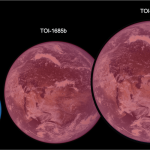Key takeaways:
- Scientists have detected phosphine in the clouds of Venus.
- Phosphine is a gas that can be produced by both biological and non-biological processes, but it is considered to be a potential biomarker for life.
- The researchers considered all possible explanations for the presence of phosphine on Venus, including both biological and non-biological sources.
- Biological processes are the most likely explanation for the presence of phosphine on Venus, but more research is needed to confirm.
- The discovery of phosphine on Venus is a significant step forward in the search for life beyond Earth.
Venus is the second planet from the Sun, and it is often called Earth’s twin because of its similar size and composition. However, Venus is a very different place from Earth. It has a dense atmosphere that is mostly made up of carbon dioxide, and the surface temperature is hot enough to melt lead.
Because of its harsh environment, Venus has long been considered to be an unlikely place for life to exist. However, a new study published in the journal Nature Astronomy suggests that Venus may be home to aerial lifeforms that float in a thin slice of habitable atmosphere, surrounded by otherwise hellish conditions.
The study was led by Clara Sousa-Silva, a researcher at the Massachusetts Institute of Technology (MIT). Sousa-Silva and her team used two different telescopes to detect phosphine in the clouds of Venus.
Phosphine is a colorless, flammable gas that has a garlic-like odor. It is produced by a variety of industrial processes, but it is also a byproduct of certain biological processes. On Earth, phosphine is produced by anaerobic bacteria, which are organisms that can live without oxygen.
Because of its association with life, phosphine is considered to be a potential biomarker for extraterrestrial life. A biomarker is a substance or characteristic that can be used to indicate the presence of life.
Sousa-Silva and her team considered all possible explanations for the presence of phosphine on Venus, including both biological and non-biological sources.
One non-biological source of phosphine is lightning. Lightning can produce phosphine through the interaction of nitrogen and phosphorus in the air. However, the researchers calculated that lightning could not produce enough phosphine to explain the amount that has been detected on Venus.
Another possible non-biological source of phosphine is volcanoes. Volcanoes can release phosphine into the atmosphere through the interaction of lava and water. However, the researchers found that there were not enough active volcanoes on Venus to produce the amount of phosphine that has been detected.
This leaves biological processes as the most likely explanation for the presence of phosphine on Venus. However, it is important to note that the detection of phosphine is not definitive proof of life. More research is needed to confirm that the phosphine on Venus is indeed produced by living organisms.
- Biological processes: Phosphine is produced by anaerobic bacteria on Earth, and it is possible that similar organisms exist in the clouds of Venus.
- Non-biological processes: Lightning and volcanoes can produce phosphine, but the researchers calculated that these processes could not produce enough phosphine to explain the amount that has been detected on Venus.
The discovery of phosphine on Venus is a significant step forward in the search for life beyond Earth. It suggests that life may be more common in the universe than we thought, and it raises the possibility that life can exist in even the most extreme environments.
More research is needed to confirm the source of the phosphine on Venus and to determine whether or not it is produced by living organisms. However, this discovery is a reminder that we are still so much we don’t know about our universe, and it gives us hope that we may not be alone.


